LSE Online Campus MODULE 6 UNIT 4 Activity Submission
VerifiedAdded on 2022/11/29
|8
|1748
|54
Homework Assignment
AI Summary
This assignment is a solution to a finance activity from the LSE Online Campus, Module 6, Unit 4. It covers key investment appraisal techniques, including calculating the Accounting Rate of Return (ARR) for a new piece of equipment, analyzing the payback period of different investment opportunities, evaluating two potential investments using the Net Present Value (NPV) technique and making investment decisions. The solution includes detailed calculations, explanations, and justifications for the investment choices. The assignment also explores the implications of a negative NPV on the Internal Rate of Return (IRR). The assignment addresses various aspects of investment decisions, providing a comprehensive understanding of financial analysis and investment appraisal methods.
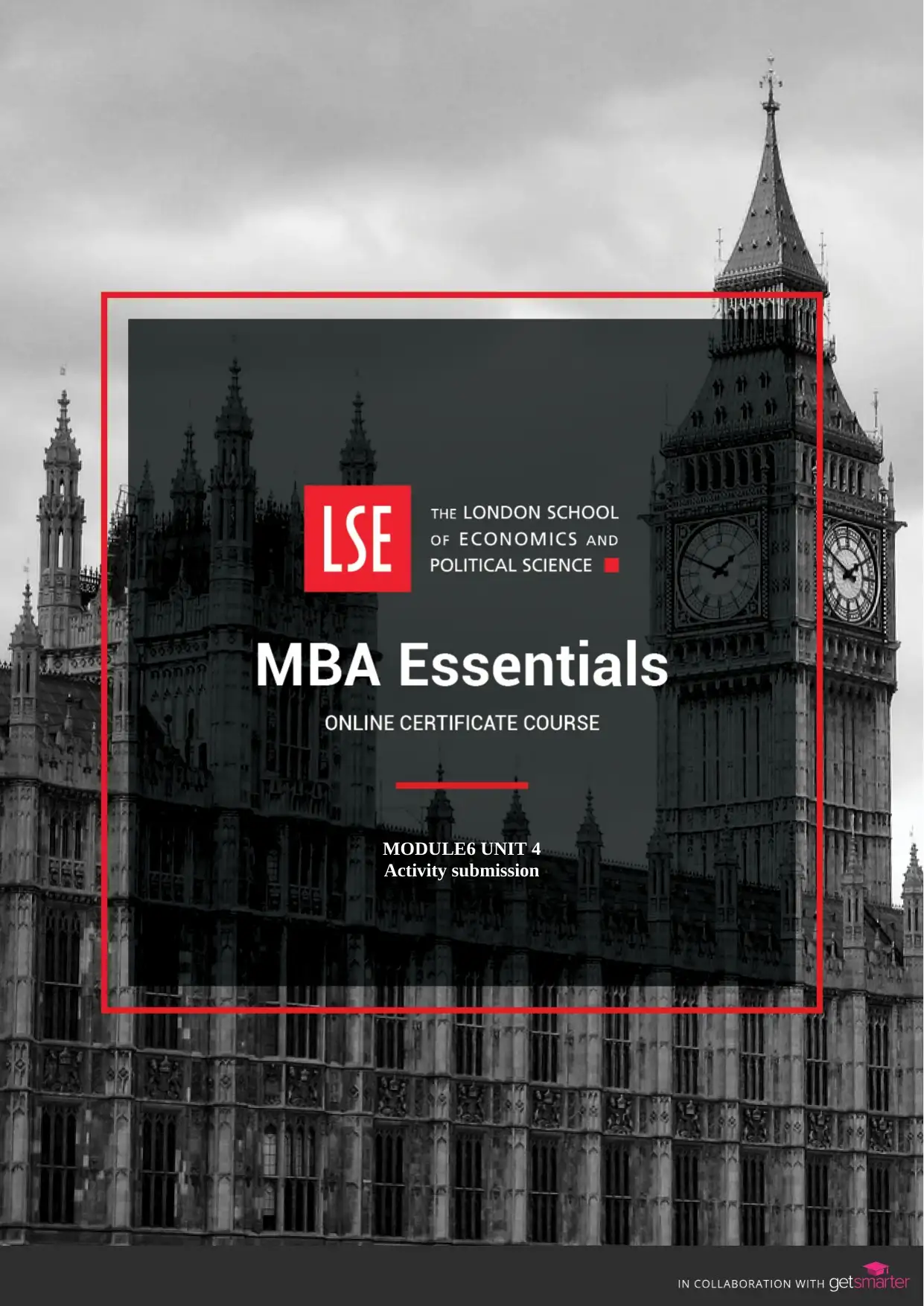
MODULE6 UNIT 4
Activity submission
Activity submission
Paraphrase This Document
Need a fresh take? Get an instant paraphrase of this document with our AI Paraphraser
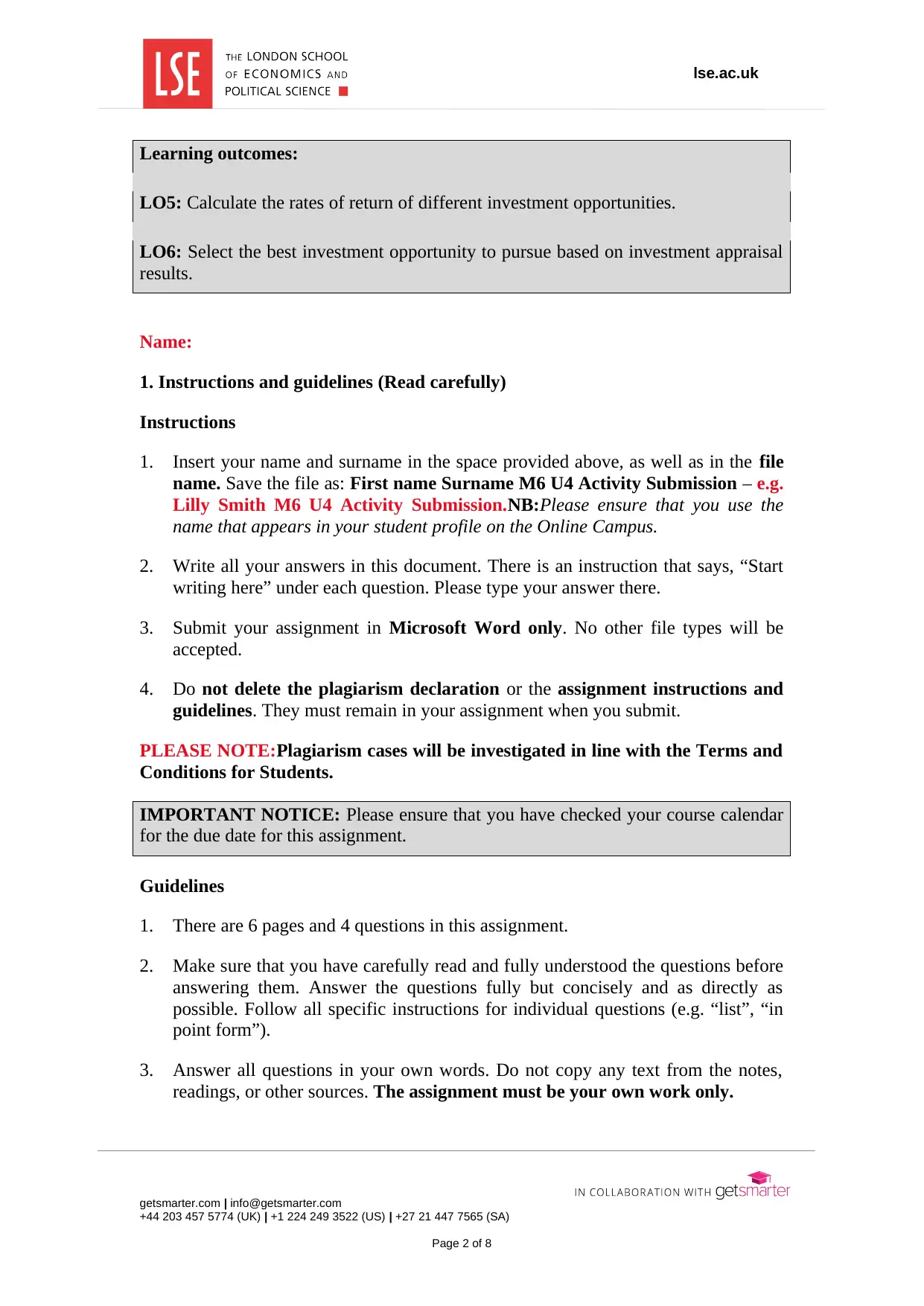
lse.ac.uk
Learning outcomes:
LO5: Calculate the rates of return of different investment opportunities.
LO6: Select the best investment opportunity to pursue based on investment appraisal
results.
Name:
1. Instructions and guidelines (Read carefully)
Instructions
1. Insert your name and surname in the space provided above, as well as in the file
name. Save the file as: First name Surname M6 U4 Activity Submission – e.g.
Lilly Smith M6 U4 Activity Submission.NB:Please ensure that you use the
name that appears in your student profile on the Online Campus.
2. Write all your answers in this document. There is an instruction that says, “Start
writing here” under each question. Please type your answer there.
3. Submit your assignment in Microsoft Word only. No other file types will be
accepted.
4. Do not delete the plagiarism declaration or the assignment instructions and
guidelines. They must remain in your assignment when you submit.
PLEASE NOTE:Plagiarism cases will be investigated in line with the Terms and
Conditions for Students.
IMPORTANT NOTICE: Please ensure that you have checked your course calendar
for the due date for this assignment.
Guidelines
1. There are 6 pages and 4 questions in this assignment.
2. Make sure that you have carefully read and fully understood the questions before
answering them. Answer the questions fully but concisely and as directly as
possible. Follow all specific instructions for individual questions (e.g. “list”, “in
point form”).
3. Answer all questions in your own words. Do not copy any text from the notes,
readings, or other sources. The assignment must be your own work only.
getsmarter.com | info@getsmarter.com
+44 203 457 5774 (UK) | +1 224 249 3522 (US) | +27 21 447 7565 (SA)
Page 2 of 8
Learning outcomes:
LO5: Calculate the rates of return of different investment opportunities.
LO6: Select the best investment opportunity to pursue based on investment appraisal
results.
Name:
1. Instructions and guidelines (Read carefully)
Instructions
1. Insert your name and surname in the space provided above, as well as in the file
name. Save the file as: First name Surname M6 U4 Activity Submission – e.g.
Lilly Smith M6 U4 Activity Submission.NB:Please ensure that you use the
name that appears in your student profile on the Online Campus.
2. Write all your answers in this document. There is an instruction that says, “Start
writing here” under each question. Please type your answer there.
3. Submit your assignment in Microsoft Word only. No other file types will be
accepted.
4. Do not delete the plagiarism declaration or the assignment instructions and
guidelines. They must remain in your assignment when you submit.
PLEASE NOTE:Plagiarism cases will be investigated in line with the Terms and
Conditions for Students.
IMPORTANT NOTICE: Please ensure that you have checked your course calendar
for the due date for this assignment.
Guidelines
1. There are 6 pages and 4 questions in this assignment.
2. Make sure that you have carefully read and fully understood the questions before
answering them. Answer the questions fully but concisely and as directly as
possible. Follow all specific instructions for individual questions (e.g. “list”, “in
point form”).
3. Answer all questions in your own words. Do not copy any text from the notes,
readings, or other sources. The assignment must be your own work only.
getsmarter.com | info@getsmarter.com
+44 203 457 5774 (UK) | +1 224 249 3522 (US) | +27 21 447 7565 (SA)
Page 2 of 8
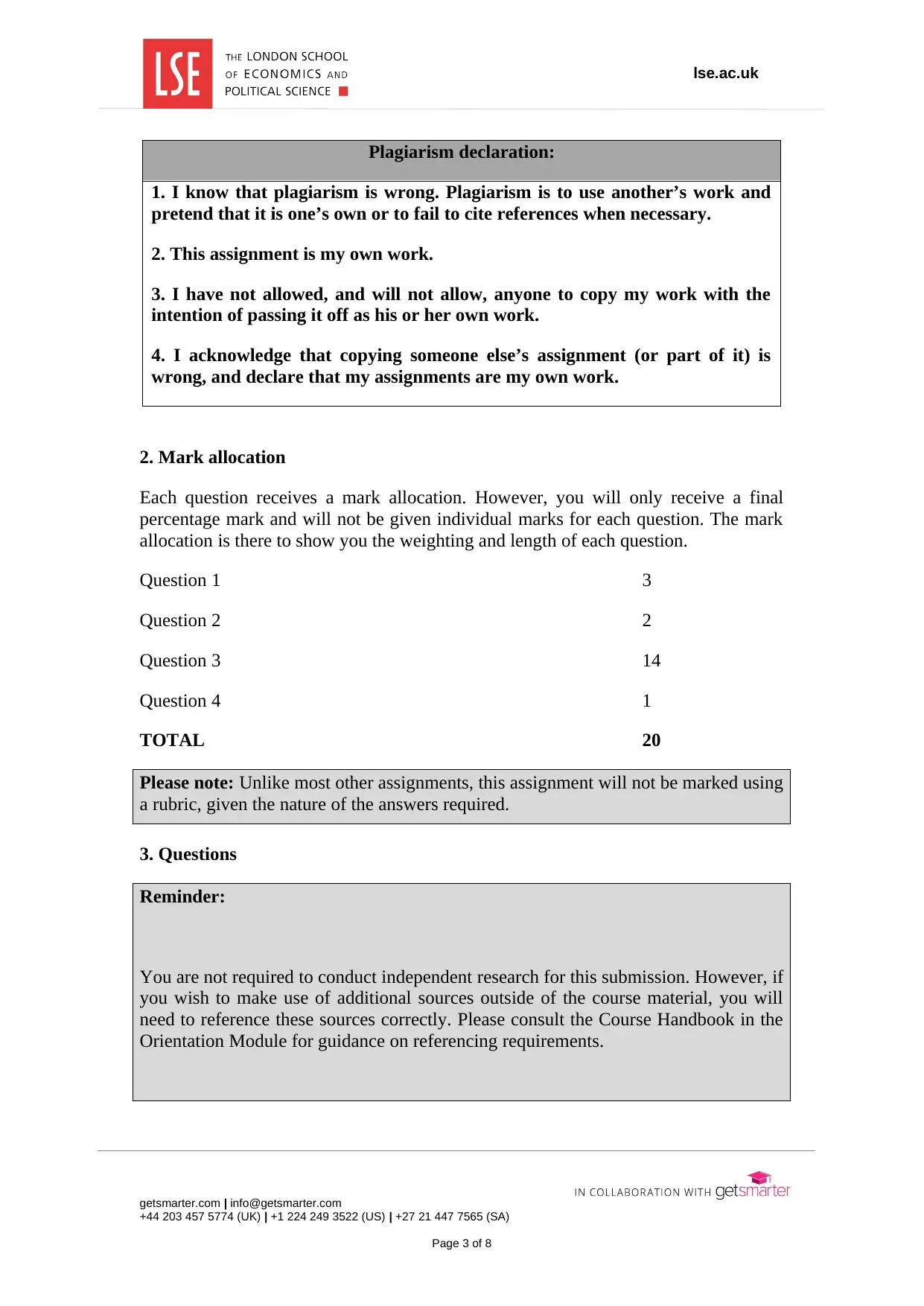
lse.ac.uk
Plagiarism declaration:
1. I know that plagiarism is wrong. Plagiarism is to use another’s work and
pretend that it is one’s own or to fail to cite references when necessary.
2. This assignment is my own work.
3. I have not allowed, and will not allow, anyone to copy my work with the
intention of passing it off as his or her own work.
4. I acknowledge that copying someone else’s assignment (or part of it) is
wrong, and declare that my assignments are my own work.
2. Mark allocation
Each question receives a mark allocation. However, you will only receive a final
percentage mark and will not be given individual marks for each question. The mark
allocation is there to show you the weighting and length of each question.
Question 1 3
Question 2 2
Question 3 14
Question 4 1
TOTAL 20
Please note: Unlike most other assignments, this assignment will not be marked using
a rubric, given the nature of the answers required.
3. Questions
Reminder:
You are not required to conduct independent research for this submission. However, if
you wish to make use of additional sources outside of the course material, you will
need to reference these sources correctly. Please consult the Course Handbook in the
Orientation Module for guidance on referencing requirements.
getsmarter.com | info@getsmarter.com
+44 203 457 5774 (UK) | +1 224 249 3522 (US) | +27 21 447 7565 (SA)
Page 3 of 8
Plagiarism declaration:
1. I know that plagiarism is wrong. Plagiarism is to use another’s work and
pretend that it is one’s own or to fail to cite references when necessary.
2. This assignment is my own work.
3. I have not allowed, and will not allow, anyone to copy my work with the
intention of passing it off as his or her own work.
4. I acknowledge that copying someone else’s assignment (or part of it) is
wrong, and declare that my assignments are my own work.
2. Mark allocation
Each question receives a mark allocation. However, you will only receive a final
percentage mark and will not be given individual marks for each question. The mark
allocation is there to show you the weighting and length of each question.
Question 1 3
Question 2 2
Question 3 14
Question 4 1
TOTAL 20
Please note: Unlike most other assignments, this assignment will not be marked using
a rubric, given the nature of the answers required.
3. Questions
Reminder:
You are not required to conduct independent research for this submission. However, if
you wish to make use of additional sources outside of the course material, you will
need to reference these sources correctly. Please consult the Course Handbook in the
Orientation Module for guidance on referencing requirements.
getsmarter.com | info@getsmarter.com
+44 203 457 5774 (UK) | +1 224 249 3522 (US) | +27 21 447 7565 (SA)
Page 3 of 8
⊘ This is a preview!⊘
Do you want full access?
Subscribe today to unlock all pages.

Trusted by 1+ million students worldwide
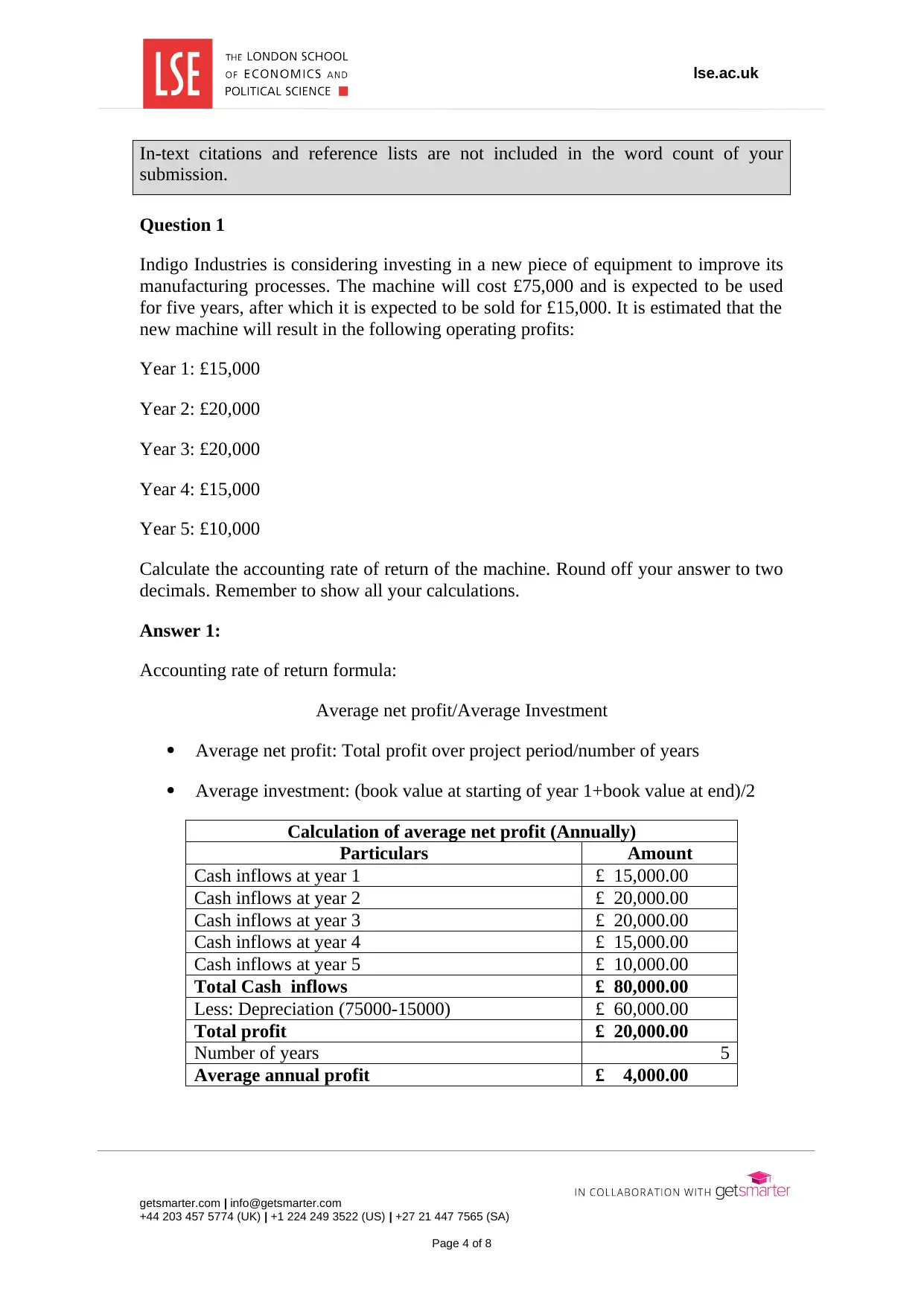
lse.ac.uk
In-text citations and reference lists are not included in the word count of your
submission.
Question 1
Indigo Industries is considering investing in a new piece of equipment to improve its
manufacturing processes. The machine will cost £75,000 and is expected to be used
for five years, after which it is expected to be sold for £15,000. It is estimated that the
new machine will result in the following operating profits:
Year 1: £15,000
Year 2: £20,000
Year 3: £20,000
Year 4: £15,000
Year 5: £10,000
Calculate the accounting rate of return of the machine. Round off your answer to two
decimals. Remember to show all your calculations.
Answer 1:
Accounting rate of return formula:
Average net profit/Average Investment
Average net profit: Total profit over project period/number of years
Average investment: (book value at starting of year 1+book value at end)/2
Calculation of average net profit (Annually)
Particulars Amount
Cash inflows at year 1 £ 15,000.00
Cash inflows at year 2 £ 20,000.00
Cash inflows at year 3 £ 20,000.00
Cash inflows at year 4 £ 15,000.00
Cash inflows at year 5 £ 10,000.00
Total Cash inflows £ 80,000.00
Less: Depreciation (75000-15000) £ 60,000.00
Total profit £ 20,000.00
Number of years 5
Average annual profit £ 4,000.00
getsmarter.com | info@getsmarter.com
+44 203 457 5774 (UK) | +1 224 249 3522 (US) | +27 21 447 7565 (SA)
Page 4 of 8
In-text citations and reference lists are not included in the word count of your
submission.
Question 1
Indigo Industries is considering investing in a new piece of equipment to improve its
manufacturing processes. The machine will cost £75,000 and is expected to be used
for five years, after which it is expected to be sold for £15,000. It is estimated that the
new machine will result in the following operating profits:
Year 1: £15,000
Year 2: £20,000
Year 3: £20,000
Year 4: £15,000
Year 5: £10,000
Calculate the accounting rate of return of the machine. Round off your answer to two
decimals. Remember to show all your calculations.
Answer 1:
Accounting rate of return formula:
Average net profit/Average Investment
Average net profit: Total profit over project period/number of years
Average investment: (book value at starting of year 1+book value at end)/2
Calculation of average net profit (Annually)
Particulars Amount
Cash inflows at year 1 £ 15,000.00
Cash inflows at year 2 £ 20,000.00
Cash inflows at year 3 £ 20,000.00
Cash inflows at year 4 £ 15,000.00
Cash inflows at year 5 £ 10,000.00
Total Cash inflows £ 80,000.00
Less: Depreciation (75000-15000) £ 60,000.00
Total profit £ 20,000.00
Number of years 5
Average annual profit £ 4,000.00
getsmarter.com | info@getsmarter.com
+44 203 457 5774 (UK) | +1 224 249 3522 (US) | +27 21 447 7565 (SA)
Page 4 of 8
Paraphrase This Document
Need a fresh take? Get an instant paraphrase of this document with our AI Paraphraser
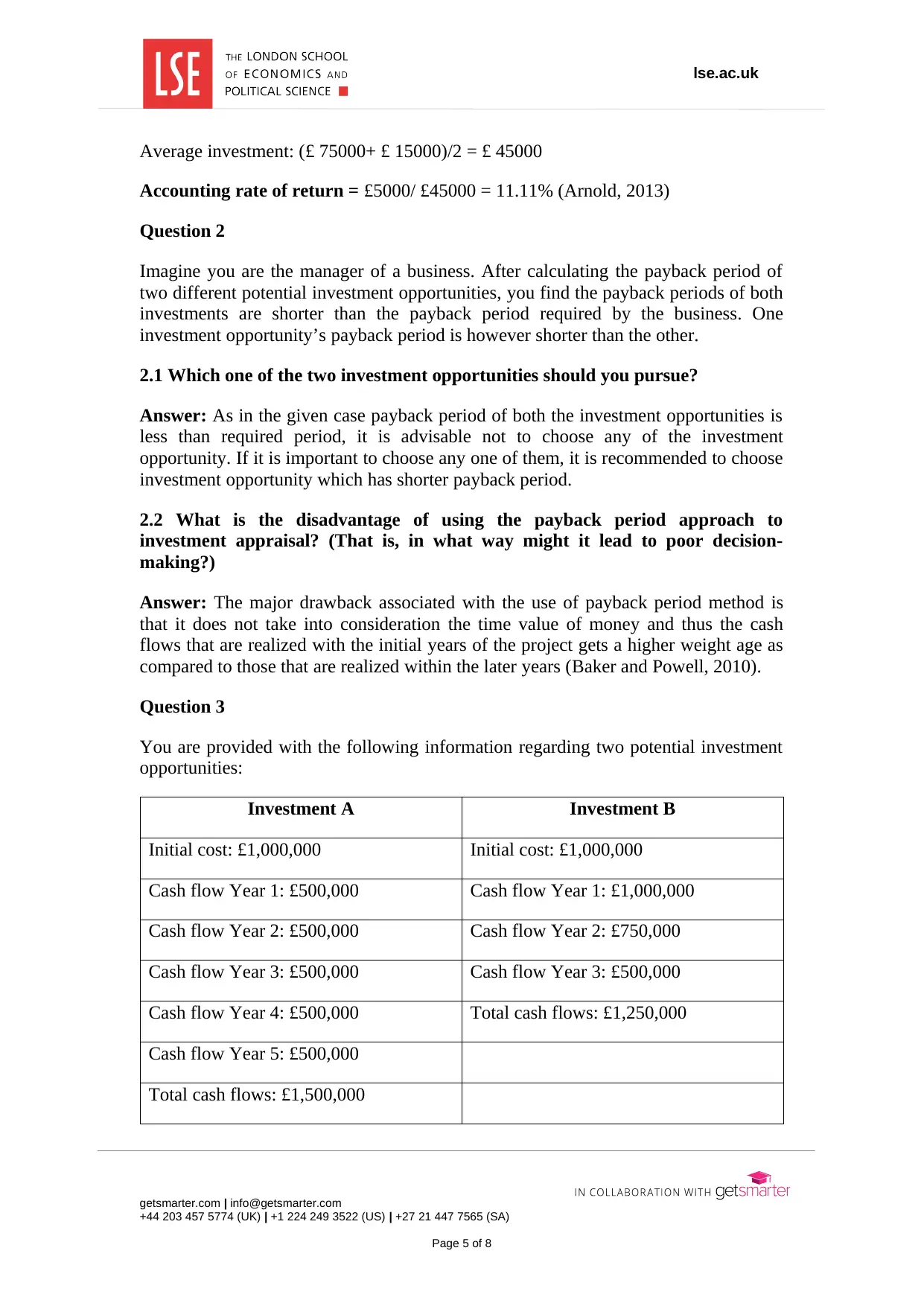
lse.ac.uk
Average investment: (£ 75000+ £ 15000)/2 = £ 45000
Accounting rate of return = £5000/ £45000 = 11.11% (Arnold, 2013)
Question 2
Imagine you are the manager of a business. After calculating the payback period of
two different potential investment opportunities, you find the payback periods of both
investments are shorter than the payback period required by the business. One
investment opportunity’s payback period is however shorter than the other.
2.1 Which one of the two investment opportunities should you pursue?
Answer: As in the given case payback period of both the investment opportunities is
less than required period, it is advisable not to choose any of the investment
opportunity. If it is important to choose any one of them, it is recommended to choose
investment opportunity which has shorter payback period.
2.2 What is the disadvantage of using the payback period approach to
investment appraisal? (That is, in what way might it lead to poor decision-
making?)
Answer: The major drawback associated with the use of payback period method is
that it does not take into consideration the time value of money and thus the cash
flows that are realized with the initial years of the project gets a higher weight age as
compared to those that are realized within the later years (Baker and Powell, 2010).
Question 3
You are provided with the following information regarding two potential investment
opportunities:
Investment A Investment B
Initial cost: £1,000,000 Initial cost: £1,000,000
Cash flow Year 1: £500,000 Cash flow Year 1: £1,000,000
Cash flow Year 2: £500,000 Cash flow Year 2: £750,000
Cash flow Year 3: £500,000 Cash flow Year 3: £500,000
Cash flow Year 4: £500,000 Total cash flows: £1,250,000
Cash flow Year 5: £500,000
Total cash flows: £1,500,000
getsmarter.com | info@getsmarter.com
+44 203 457 5774 (UK) | +1 224 249 3522 (US) | +27 21 447 7565 (SA)
Page 5 of 8
Average investment: (£ 75000+ £ 15000)/2 = £ 45000
Accounting rate of return = £5000/ £45000 = 11.11% (Arnold, 2013)
Question 2
Imagine you are the manager of a business. After calculating the payback period of
two different potential investment opportunities, you find the payback periods of both
investments are shorter than the payback period required by the business. One
investment opportunity’s payback period is however shorter than the other.
2.1 Which one of the two investment opportunities should you pursue?
Answer: As in the given case payback period of both the investment opportunities is
less than required period, it is advisable not to choose any of the investment
opportunity. If it is important to choose any one of them, it is recommended to choose
investment opportunity which has shorter payback period.
2.2 What is the disadvantage of using the payback period approach to
investment appraisal? (That is, in what way might it lead to poor decision-
making?)
Answer: The major drawback associated with the use of payback period method is
that it does not take into consideration the time value of money and thus the cash
flows that are realized with the initial years of the project gets a higher weight age as
compared to those that are realized within the later years (Baker and Powell, 2010).
Question 3
You are provided with the following information regarding two potential investment
opportunities:
Investment A Investment B
Initial cost: £1,000,000 Initial cost: £1,000,000
Cash flow Year 1: £500,000 Cash flow Year 1: £1,000,000
Cash flow Year 2: £500,000 Cash flow Year 2: £750,000
Cash flow Year 3: £500,000 Cash flow Year 3: £500,000
Cash flow Year 4: £500,000 Total cash flows: £1,250,000
Cash flow Year 5: £500,000
Total cash flows: £1,500,000
getsmarter.com | info@getsmarter.com
+44 203 457 5774 (UK) | +1 224 249 3522 (US) | +27 21 447 7565 (SA)
Page 5 of 8
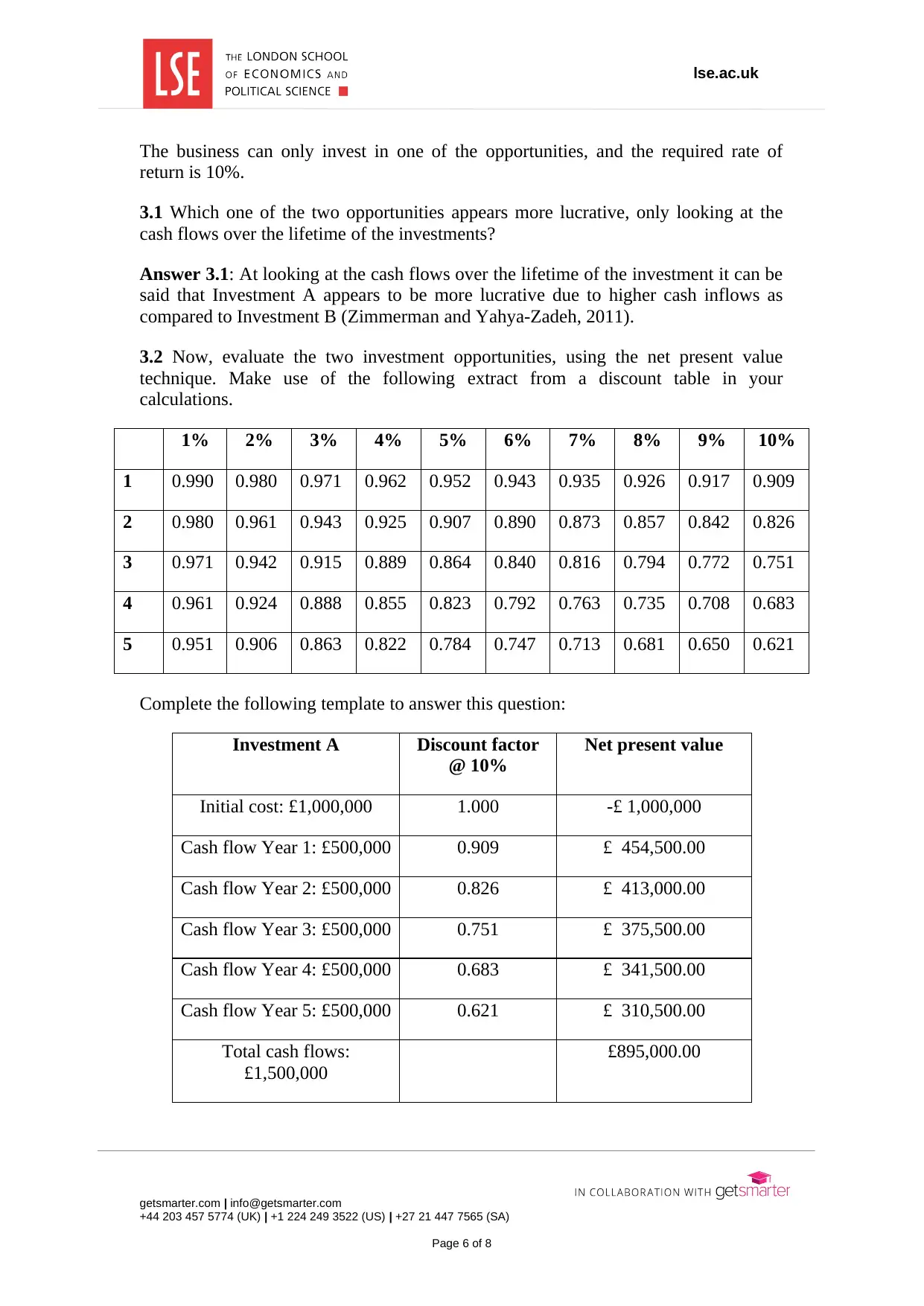
lse.ac.uk
The business can only invest in one of the opportunities, and the required rate of
return is 10%.
3.1 Which one of the two opportunities appears more lucrative, only looking at the
cash flows over the lifetime of the investments?
Answer 3.1: At looking at the cash flows over the lifetime of the investment it can be
said that Investment A appears to be more lucrative due to higher cash inflows as
compared to Investment B (Zimmerman and Yahya-Zadeh, 2011).
3.2 Now, evaluate the two investment opportunities, using the net present value
technique. Make use of the following extract from a discount table in your
calculations.
1% 2% 3% 4% 5% 6% 7% 8% 9% 10%
1 0.990 0.980 0.971 0.962 0.952 0.943 0.935 0.926 0.917 0.909
2 0.980 0.961 0.943 0.925 0.907 0.890 0.873 0.857 0.842 0.826
3 0.971 0.942 0.915 0.889 0.864 0.840 0.816 0.794 0.772 0.751
4 0.961 0.924 0.888 0.855 0.823 0.792 0.763 0.735 0.708 0.683
5 0.951 0.906 0.863 0.822 0.784 0.747 0.713 0.681 0.650 0.621
Complete the following template to answer this question:
Investment A Discount factor
@ 10%
Net present value
Initial cost: £1,000,000 1.000 -£ 1,000,000
Cash flow Year 1: £500,000 0.909 £ 454,500.00
Cash flow Year 2: £500,000 0.826 £ 413,000.00
Cash flow Year 3: £500,000 0.751 £ 375,500.00
Cash flow Year 4: £500,000 0.683 £ 341,500.00
Cash flow Year 5: £500,000 0.621 £ 310,500.00
Total cash flows:
£1,500,000
£895,000.00
getsmarter.com | info@getsmarter.com
+44 203 457 5774 (UK) | +1 224 249 3522 (US) | +27 21 447 7565 (SA)
Page 6 of 8
The business can only invest in one of the opportunities, and the required rate of
return is 10%.
3.1 Which one of the two opportunities appears more lucrative, only looking at the
cash flows over the lifetime of the investments?
Answer 3.1: At looking at the cash flows over the lifetime of the investment it can be
said that Investment A appears to be more lucrative due to higher cash inflows as
compared to Investment B (Zimmerman and Yahya-Zadeh, 2011).
3.2 Now, evaluate the two investment opportunities, using the net present value
technique. Make use of the following extract from a discount table in your
calculations.
1% 2% 3% 4% 5% 6% 7% 8% 9% 10%
1 0.990 0.980 0.971 0.962 0.952 0.943 0.935 0.926 0.917 0.909
2 0.980 0.961 0.943 0.925 0.907 0.890 0.873 0.857 0.842 0.826
3 0.971 0.942 0.915 0.889 0.864 0.840 0.816 0.794 0.772 0.751
4 0.961 0.924 0.888 0.855 0.823 0.792 0.763 0.735 0.708 0.683
5 0.951 0.906 0.863 0.822 0.784 0.747 0.713 0.681 0.650 0.621
Complete the following template to answer this question:
Investment A Discount factor
@ 10%
Net present value
Initial cost: £1,000,000 1.000 -£ 1,000,000
Cash flow Year 1: £500,000 0.909 £ 454,500.00
Cash flow Year 2: £500,000 0.826 £ 413,000.00
Cash flow Year 3: £500,000 0.751 £ 375,500.00
Cash flow Year 4: £500,000 0.683 £ 341,500.00
Cash flow Year 5: £500,000 0.621 £ 310,500.00
Total cash flows:
£1,500,000
£895,000.00
getsmarter.com | info@getsmarter.com
+44 203 457 5774 (UK) | +1 224 249 3522 (US) | +27 21 447 7565 (SA)
Page 6 of 8
⊘ This is a preview!⊘
Do you want full access?
Subscribe today to unlock all pages.

Trusted by 1+ million students worldwide
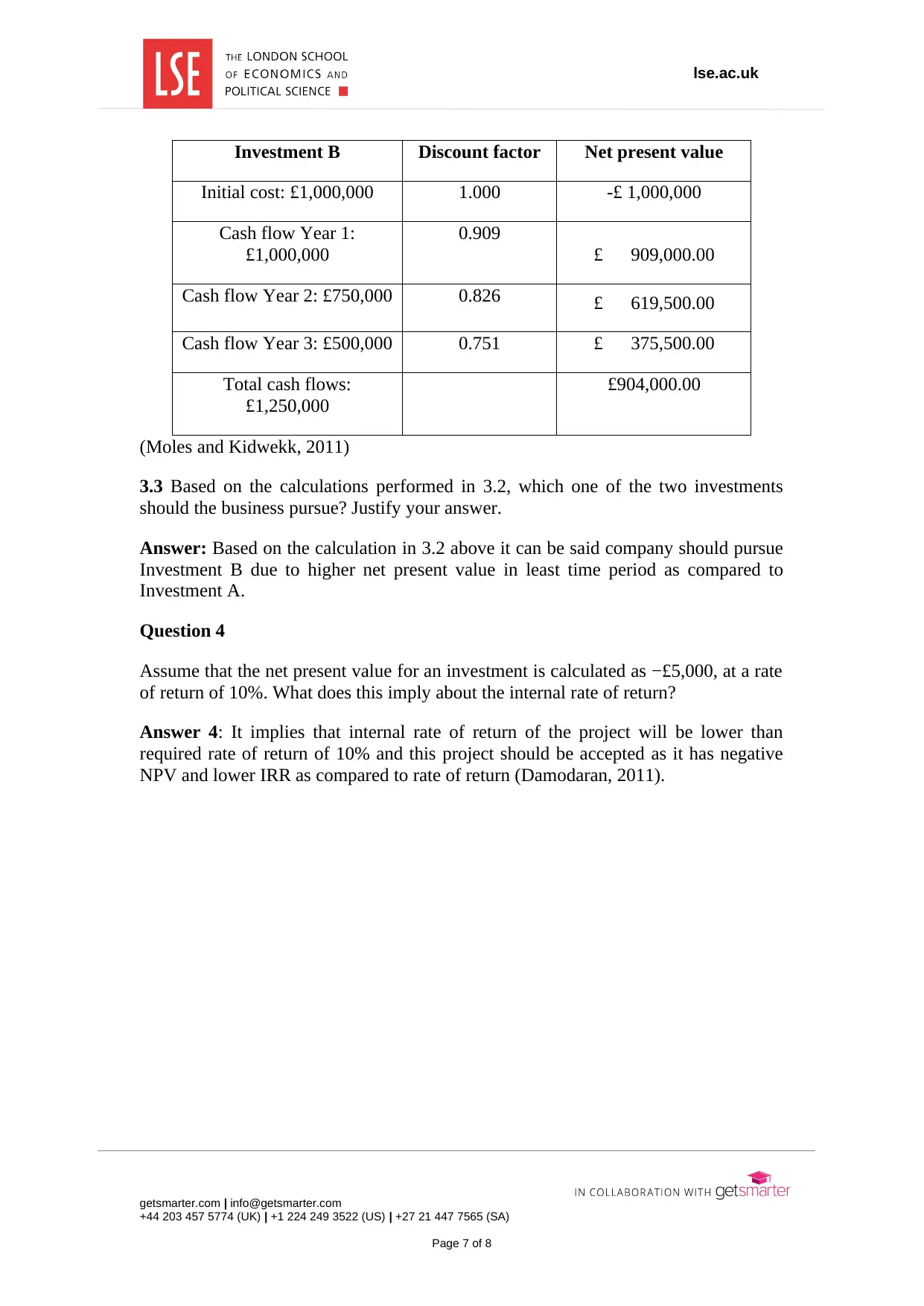
lse.ac.uk
Investment B Discount factor Net present value
Initial cost: £1,000,000 1.000 -£ 1,000,000
Cash flow Year 1:
£1,000,000
0.909
£ 909,000.00
Cash flow Year 2: £750,000 0.826 £ 619,500.00
Cash flow Year 3: £500,000 0.751 £ 375,500.00
Total cash flows:
£1,250,000
£904,000.00
(Moles and Kidwekk, 2011)
3.3 Based on the calculations performed in 3.2, which one of the two investments
should the business pursue? Justify your answer.
Answer: Based on the calculation in 3.2 above it can be said company should pursue
Investment B due to higher net present value in least time period as compared to
Investment A.
Question 4
Assume that the net present value for an investment is calculated as −£5,000, at a rate
of return of 10%. What does this imply about the internal rate of return?
Answer 4: It implies that internal rate of return of the project will be lower than
required rate of return of 10% and this project should be accepted as it has negative
NPV and lower IRR as compared to rate of return (Damodaran, 2011).
getsmarter.com | info@getsmarter.com
+44 203 457 5774 (UK) | +1 224 249 3522 (US) | +27 21 447 7565 (SA)
Page 7 of 8
Investment B Discount factor Net present value
Initial cost: £1,000,000 1.000 -£ 1,000,000
Cash flow Year 1:
£1,000,000
0.909
£ 909,000.00
Cash flow Year 2: £750,000 0.826 £ 619,500.00
Cash flow Year 3: £500,000 0.751 £ 375,500.00
Total cash flows:
£1,250,000
£904,000.00
(Moles and Kidwekk, 2011)
3.3 Based on the calculations performed in 3.2, which one of the two investments
should the business pursue? Justify your answer.
Answer: Based on the calculation in 3.2 above it can be said company should pursue
Investment B due to higher net present value in least time period as compared to
Investment A.
Question 4
Assume that the net present value for an investment is calculated as −£5,000, at a rate
of return of 10%. What does this imply about the internal rate of return?
Answer 4: It implies that internal rate of return of the project will be lower than
required rate of return of 10% and this project should be accepted as it has negative
NPV and lower IRR as compared to rate of return (Damodaran, 2011).
getsmarter.com | info@getsmarter.com
+44 203 457 5774 (UK) | +1 224 249 3522 (US) | +27 21 447 7565 (SA)
Page 7 of 8
Paraphrase This Document
Need a fresh take? Get an instant paraphrase of this document with our AI Paraphraser
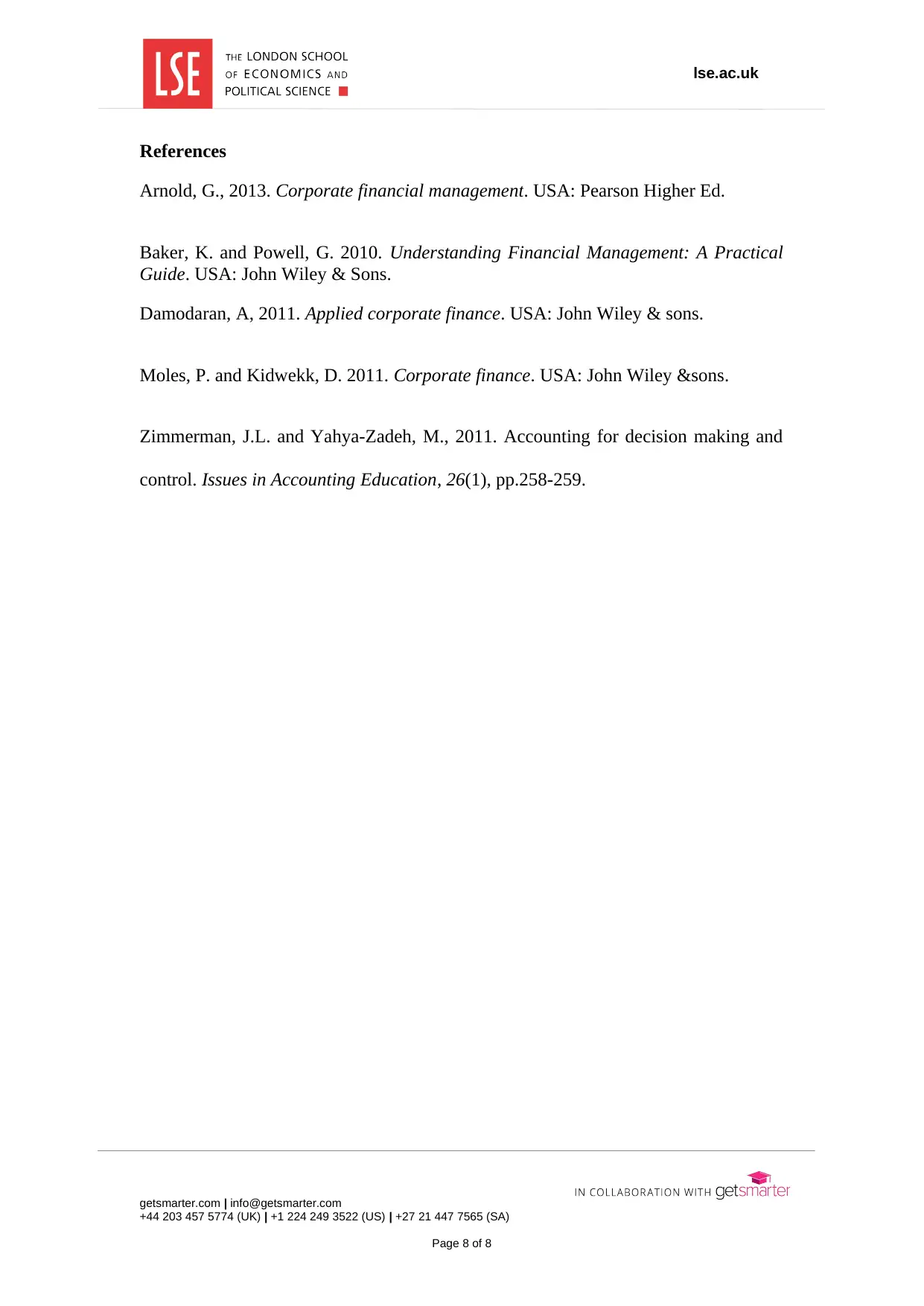
lse.ac.uk
References
Arnold, G., 2013. Corporate financial management. USA: Pearson Higher Ed.
Baker, K. and Powell, G. 2010. Understanding Financial Management: A Practical
Guide. USA: John Wiley & Sons.
Damodaran, A, 2011. Applied corporate finance. USA: John Wiley & sons.
Moles, P. and Kidwekk, D. 2011. Corporate finance. USA: John Wiley &sons.
Zimmerman, J.L. and Yahya-Zadeh, M., 2011. Accounting for decision making and
control. Issues in Accounting Education, 26(1), pp.258-259.
getsmarter.com | info@getsmarter.com
+44 203 457 5774 (UK) | +1 224 249 3522 (US) | +27 21 447 7565 (SA)
Page 8 of 8
References
Arnold, G., 2013. Corporate financial management. USA: Pearson Higher Ed.
Baker, K. and Powell, G. 2010. Understanding Financial Management: A Practical
Guide. USA: John Wiley & Sons.
Damodaran, A, 2011. Applied corporate finance. USA: John Wiley & sons.
Moles, P. and Kidwekk, D. 2011. Corporate finance. USA: John Wiley &sons.
Zimmerman, J.L. and Yahya-Zadeh, M., 2011. Accounting for decision making and
control. Issues in Accounting Education, 26(1), pp.258-259.
getsmarter.com | info@getsmarter.com
+44 203 457 5774 (UK) | +1 224 249 3522 (US) | +27 21 447 7565 (SA)
Page 8 of 8
1 out of 8
Related Documents
Your All-in-One AI-Powered Toolkit for Academic Success.
+13062052269
info@desklib.com
Available 24*7 on WhatsApp / Email
![[object Object]](/_next/static/media/star-bottom.7253800d.svg)
Unlock your academic potential
Copyright © 2020–2025 A2Z Services. All Rights Reserved. Developed and managed by ZUCOL.





